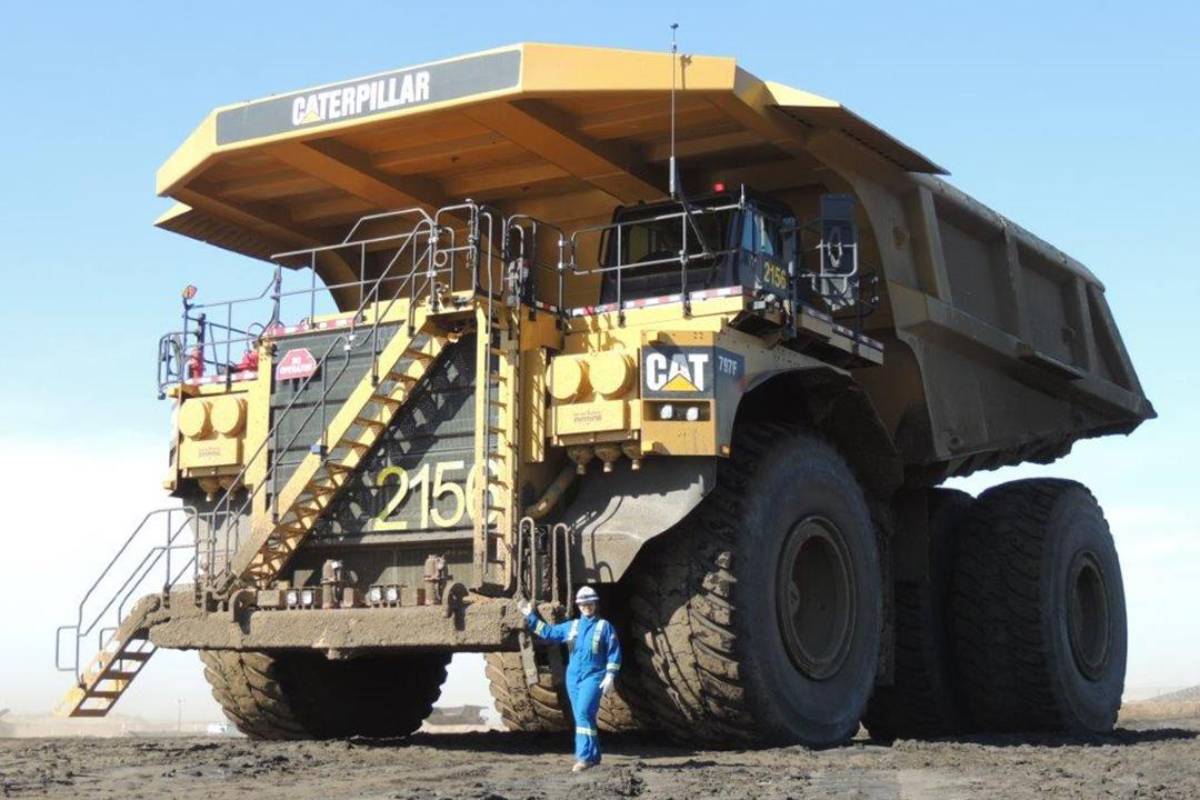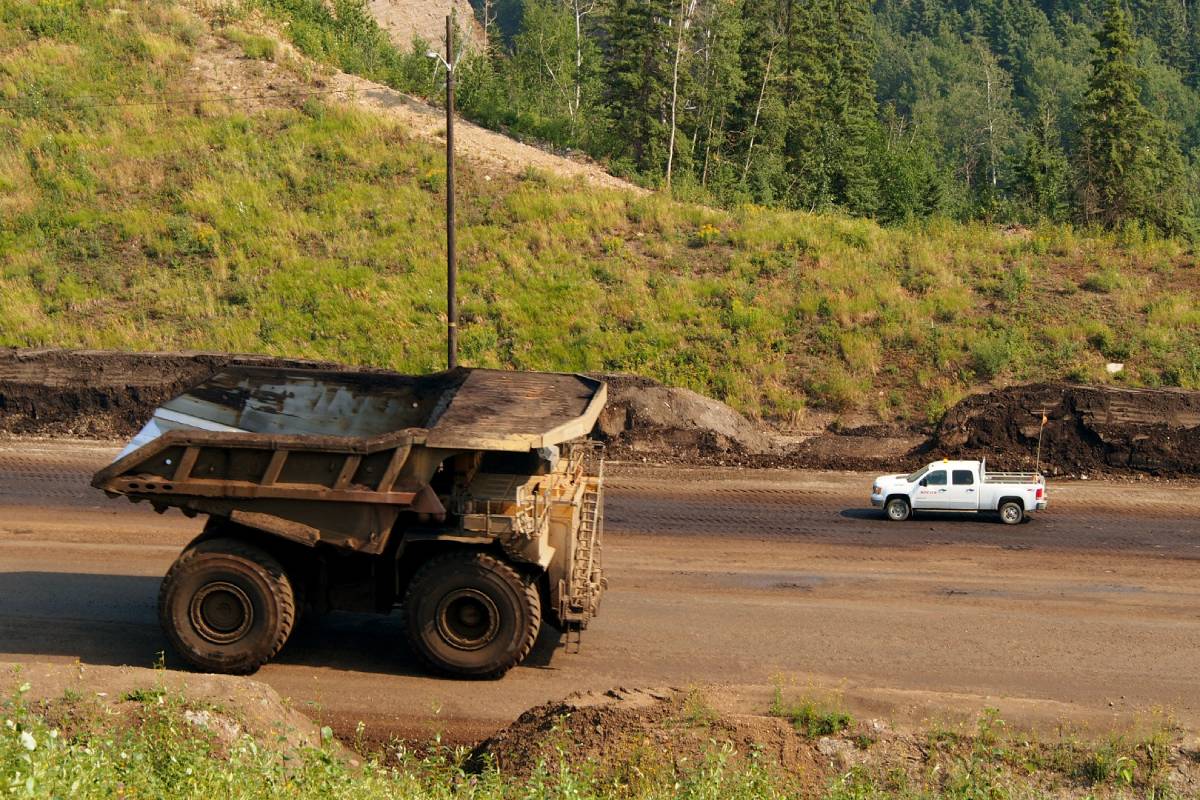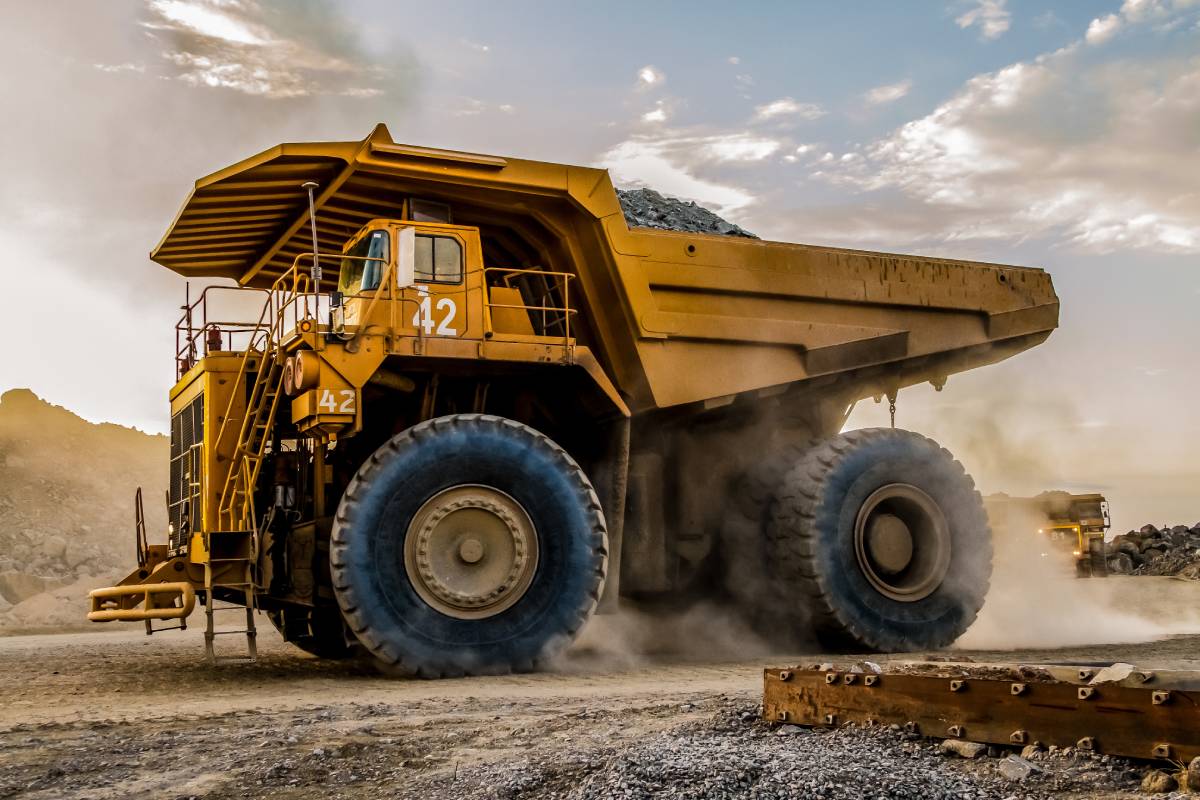In the world of heavy machinery, few things command attention quite like the Caterpillar 797F. Picture a colossal beast of burden, towering over the landscape with tyres as tall as a small house and a roar that could wake the dead. This mammoth machine isn’t just your average truck—it’s a powerhouse designed to tackle the toughest jobs in the most extreme conditions.
But what exactly sets the Caterpillar 797F apart from the rest? Let’s dive into the details and uncover what makes this giant of the haul truck world so special.
What is Caterpillar 797?
The Caterpillar 797 is not your average truck. In fact, it’s more like a colossal beast of burden, designed to tackle the toughest jobs in the most extreme conditions. Picture this: a mammoth machine towering over the landscape, with tyres as tall as a small house and a roar that could wake the dead. That’s the Caterpillar 797, the largest truck in the world.
So, what exactly is the Caterpillar 797 and what makes it so special? Let’s break it down in simple terms.
At its core, the Caterpillar 797 is an ultra-heavy-duty haul truck used primarily in mining operations. Its main job? Hauling enormous amounts of material—think mountains of dirt, rocks, and ore—from one place to another within a mine site. But this isn’t your typical pickup truck we’re talking about. The 797 is a behemoth, capable of carrying payloads of up to 400 metric tons! To put that into perspective, that’s roughly the weight of 300 average-sized cars!
Now, let’s talk about size. When we say the Caterpillar 797 is big, we mean BIG. These trucks can stretch up to 15 meters in length, stand over 7 meters tall, and weigh as much as 635 metric tonnes when fully loaded. That’s like having a small skyscraper cruising down the mine roads!
But size alone isn’t what sets the Caterpillar 797 apart. It’s also about power. These trucks are equipped with massive diesel engines that can generate over 2,980 kilowatts (4,000 HP)—that’s more muscle than a herd of elephants! And with all that power under the hood, the 797 can reach speeds of up to 64 kilometres per hour, which is pretty impressive considering its size.
Now, you might be wondering how something so massive manages to move around without sinking into the ground like a lead balloon. Well, that’s where the tyres come in. The Caterpillar 797 rides on a set of specially designed tyres that are over 4 meters tall and weigh as much as a small elephant. These tyres are built to withstand the immense weight of the truck and provide the traction needed to navigate the rough terrain of a mine site.
But the Caterpillar 797 isn’t just about brute force and size—it’s also about efficiency. These trucks are equipped with advanced technology that helps optimize fuel consumption, reduce emissions, and maximize productivity. From onboard computer systems that monitor engine performance to automated controls that help operators navigate tricky terrain, the 797 is a marvel of modern engineering.
In addition to its impressive size and power, the Caterpillar 797 is also designed with safety in mind. These trucks are equipped with features like rollover protection systems, collision avoidance systems, and advanced braking technology to help keep both operators and bystanders safe.
So, whether it’s hauling tons of earth in a massive open-pit mine or navigating the rugged terrain of a remote construction site, the Caterpillar 797 is up to the task. With its unparalleled combination of size, power, and technology, it’s no wonder why the 797 is considered the king of the haul truck world.

What is the difference between 797B and 797F?
Understanding the differences between the Caterpillar 797B and the Caterpillar 797F might feel like deciphering between two closely related cousins, but fear not! I’ll break it down into bite-sized pieces for you.
Let’s start with the basics. Both the 797B and the 797F belong to the same family of ultra-heavy-duty haul trucks designed for mammoth tasks in mining operations. Think of them as siblings with similar genes but distinct personalities.
The first notable difference between the two lies in their release years. The 797B was introduced back in the late 1990s, while its younger sibling, the 797F, came into the scene later in the 2000s. This age gap means that the 797F benefits from advancements in technology and design that might not be present in the older model.
One of the most significant improvements in the 797F is its engine. While both trucks boast powerful diesel engines, the 797F’s engine is more refined and efficient, offering better fuel economy and lower emissions compared to its predecessor. This means that not only does the 797F pack a punch in terms of power, but it also does so while being more environmentally friendly—a win-win situation!
Another area where the 797F shines is in its payload capacity. Thanks to clever engineering and design tweaks, the 797F can carry even larger loads compared to the 797B. This means fewer trips back and forth for hauling materials, translating to increased productivity and efficiency for mining operations.
Now, let’s talk about comfort and convenience. Mining is no easy job, and operators spend long hours behind the wheel of these massive trucks. That’s why the 797F comes equipped with a more comfortable and ergonomic cabin compared to the 797B. With features like adjustable seats, improved visibility, and better climate control, operators can tackle their shifts with less fatigue and more focus.
Safety is always a top priority, especially in high-risk environments like mines. While both the 797B and the 797F are equipped with safety features, the 797F takes it a step further with the integration of advanced collision avoidance systems, enhanced braking technology, and improved rollover protection. These additional safety measures help mitigate risks and ensure the well-being of operators and workers on-site.
Last but not least, let’s talk about maintenance and reliability. The 797F benefits from years of feedback and real-world testing, resulting in a more robust and reliable machine compared to its predecessor. With improved durability and easier access to key components for maintenance, the 797F is designed to minimize downtime and keep operations running smoothly.

Is the Caterpillar 797 fuel efficient?
When it comes to fuel efficiency, the Caterpillar 797 might not be the first truck that comes to mind. After all, we’re talking about a massive machine that weighs as much as a small mountain and guzzles diesel like there’s no tomorrow. But don’t let its size fool you—there’s more to the story than meets the eye.
Let’s start by addressing the elephant in the room: yes, the Caterpillar 797 is a thirsty beast. With a massive diesel engine churning out thousands of horsepower, it’s no surprise that it consumes a significant amount of fuel. However, what sets the 797 apart is its remarkable efficiency given its size and the magnitude of the tasks it performs.
You see, the Caterpillar 797 is not your average truck. It’s a specialized machine designed for hauling massive loads in the most demanding environments, such as open-pit mines. And in these extreme conditions, efficiency is about more than just miles per gallon—it’s about getting the job done in the most cost-effective and productive way possible.
One way the 797 achieves this is through advanced engine technology. While it may not win any awards for being the most fuel-efficient vehicle on the road, its diesel engine is optimized for power and performance, delivering the muscle needed to haul payloads weighing hundreds of tons across rugged terrain. And thanks to innovations in engine design and fuel management systems, newer models like the 797F boast improved fuel economy compared to their predecessors.
But fuel efficiency isn’t just about what happens under the hood—it’s also about how the truck is driven and operated. The Caterpillar 797 is equipped with advanced onboard computer systems and telematics that monitor engine performance, optimize fuel consumption, and provide real-time data to operators and fleet managers. This allows them to make informed decisions to maximize efficiency, whether it’s adjusting speed and acceleration or optimizing route planning to minimize fuel usage.
Another factor that contributes to the Caterpillar 797’s efficiency is its sheer size. While it may seem counterintuitive, larger trucks like the 797 can actually be more fuel-efficient than smaller vehicles when it comes to hauling heavy loads over long distances. That’s because they can take advantage of economies of scale, spreading the fuel cost over a larger payload and reducing the fuel consumed per ton-mile.
Of course, like any machine, the Caterpillar 797’s fuel efficiency ultimately depends on how it’s used and maintained. Regular maintenance, proper tyre inflation, and efficient driving practices all play a role in maximizing fuel economy and reducing operating costs over the long term.
So, is the Caterpillar 797 fuel-efficient? In the context of its size, power, and the demanding tasks it performs, the answer is yes. While it may not be winning any green awards anytime soon, it’s a testament to the ingenuity and engineering prowess of Caterpillar that such a massive machine can still achieve impressive levels of efficiency in the world of heavy-duty hauling.

How much does a 797F mining truck cost?
The Caterpillar 797F mining truck isn’t just a piece of heavy machinery—it’s a colossal investment. When you’re dealing with a machine that’s built to tackle the toughest jobs in the most extreme conditions, you can expect the price tag to reflect its capabilities. So, how much does a Caterpillar 797F mining truck cost? Let’s dig into the numbers.
To put it simply, the cost of a Caterpillar 797F mining truck can vary widely depending on a variety of factors, including configuration, optional features, and market conditions. However, you can expect to pay somewhere in the ballpark of several million dollars for one of these behemoths.
Let’s break it down a bit further. The base price of a Caterpillar 797F mining truck starts at around $5 million USD. But that’s just the starting point. From there, the price can quickly escalate as you add optional features and customization to suit the specific needs of your mining operation.
One of the biggest factors influencing the cost of a Caterpillar 797F is its payload capacity. These trucks come in several different configurations, with payload capacities ranging from around 360 to 400 tons. The higher the payload capacity, the higher the price tag. So, if you need a truck that can haul massive loads, be prepared to shell out a few extra million dollars.
In addition to payload capacity, optional features can also drive up the cost of a Caterpillar 797F. From advanced technology packages to specialized equipment for specific mining applications, there’s no shortage of add-ons available to customize your truck. Whether it’s enhanced safety systems, advanced telematics, or ergonomic operator cabins, these optional features can add hundreds of thousands of dollars to the final price.
Of course, the cost of a Caterpillar 797F doesn’t end with the initial purchase. Operating and maintaining these trucks also come with significant expenses. Fuel, tyres, maintenance, and repairs can all add up over the lifespan of the vehicle, not to mention the cost of employing skilled operators to run them.
But despite the hefty price tag, investing in a Caterpillar 797F mining truck can offer significant returns for mining operations. With its unparalleled combination of size, power, and efficiency, the 797F is designed to maximize productivity and minimize operating costs over the long term. And in an industry where time is money, having the right equipment can make all the difference.
So, while the cost of a Caterpillar 797F mining truck may seem eye-watering at first glance, it’s important to consider the value it brings to the table. For mining operations that demand the best, the 797F is more than just a truck—it’s an investment in success.

How can I improve my CAT 797F performance?
Improving the performance of a Caterpillar 797F mining truck involves a combination of optimizing its operation, maintenance, and utilization of available technology. Here are some key strategies to enhance its performance:
- Driver Training and Skill Development: Investing in comprehensive training programs for truck drivers can significantly improve truck performance. Operators should be trained in efficient driving techniques, such as smooth acceleration and braking, maintaining consistent speeds, and proper use of engine power modes.
- Utilize Advanced Technology: Take advantage of the advanced technology and onboard systems available in the Caterpillar 797F. This includes features like integrated payload monitoring systems, engine performance analytics, and automated controls for optimizing fuel consumption and productivity. Additionally, consider upgrading the Caterpillar 797F exhausts with advanced emission control systems to reduce environmental impact and comply with regulatory standards.
- Regular Maintenance and Inspections: Ensure that the truck undergoes regular maintenance according to the manufacturer’s recommendations. This includes scheduled inspections, oil changes, filter replacements, and component lubrication to keep the truck running smoothly and prevent unexpected downtime. Pay special attention to the condition of the Caterpillar 797F exhausts, as exhaust system maintenance is essential for optimizing engine performance and minimizing emissions.
- Optimize Payloads: Properly managing payloads is crucial for maximizing the performance and efficiency of the Caterpillar 797F. Avoid overloading the truck, as this can strain the engine and drivetrain, leading to increased fuel consumption and wear and tear on components. Utilize onboard payload monitoring systems to ensure that loads are within recommended limits.
- Monitor Tire Condition and Pressure: Tires play a critical role in the performance and safety of the Caterpillar 797F. Regularly check tyre condition, tread depth, and inflation pressure to optimize traction, stability, and fuel efficiency. Proper tyre maintenance can also extend tyre life and reduce operating costs.
- Implement Predictive Maintenance Practices: Embrace predictive maintenance techniques, such as condition monitoring and remote diagnostics, to identify potential issues before they escalate into costly failures. By proactively addressing maintenance needs, you can minimize unplanned downtime and maximize uptime for the truck.
- Upgrade to Latest Technology: Consider upgrading the Caterpillar 797F with the latest technology and equipment offerings from the manufacturer. This could include retrofitting advanced safety systems, engine upgrades, or implementing software updates to improve performance and efficiency.
- Monitor and Analyze Performance Data: Utilize telematics and data analytics tools to monitor and analyze performance data from the Caterpillar 797F in real-time. This can provide valuable insights into fuel consumption, productivity, operator behaviour, and equipment health, allowing for informed decision-making to optimize performance.
Implementing these strategies will help you boost the performance, efficiency, and reliability of your Caterpillar 797F mining truck, allowing you to maximize productivity and profitability for your mining operation.
In conclusion
The Caterpillar 797F is a giant among giants in the world of mining and heavy industry, boasting unmatched size, power, and tech smarts. This monster truck is all about hauling massive loads in open-pit mines and tackling tough terrain like it’s nothing. It’s not just setting the bar for performance and efficiency; it’s flying right over it.
The 797F combines raw strength with the latest tech, proving it’s more than just machinery—it’s a shining example of what humans can dream up and build. Whether it’s ruling the bottom of a mine or bossing around a construction site, the Caterpillar 797F is the undisputed champ of haul trucks, always up for a challenge.

